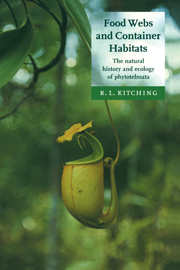Part III - Patterns in phytotelm food webs
Published online by Cambridge University Press: 26 August 2009
Summary
The Nothofagus beech forests of northern New South Wales may not have been the models for Tolkien's Fangorn but the similarities are striking. The gnarled and convoluted trunks of these survivors of the great forests of Gondwana are covered in Spanish moss and wreathed in mists on many a morning. Perched in the high country and experiencing a changing, sometimes severe and often moist climate, these extraordinary rainforests are home to the superb lyrebird, the olive whistler and, even, the strange bristle bird – itself a survivor, perhaps, of the earliest passerines originating on this ancient land mass. The lyrebird reveals itself, more often than not, by piercing mimicry of other species – often at a volume that the original models could never match! Other inhabitants are less obvious in their presence: a grey kangaroo looms out of the mist by the side of the track, a much smaller swamp wallaby scuttles into the undergrowth as we approach.
Presenting the utmost contrast, the lowland rainforests of the Daintree north of Cairns in Australia's wet tropics tumble down to golden beaches in an effulgence of luxuriant vegetation. The wet season here is warm, and the field worker may often experience that extraordinary sensation of watery continuity as the warm monsoonal rain buckets down from above to join the standing water on the forest floor and the temporarily intercepted ‘drip layer’ in between.
- Type
- Chapter
- Information
- Food Webs and Container HabitatsThe Natural History and Ecology of Phytotelmata, pp. 137 - 138Publisher: Cambridge University PressPrint publication year: 2000



